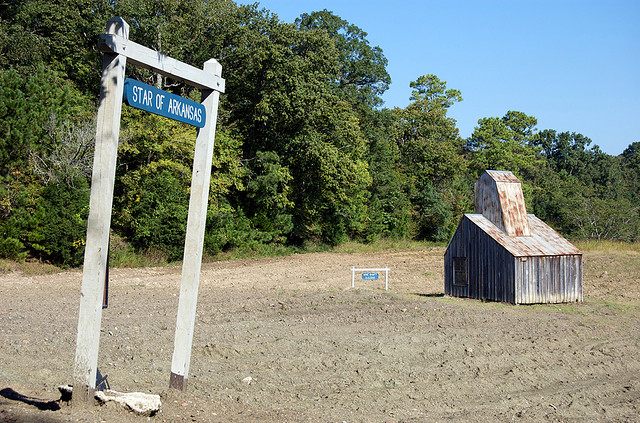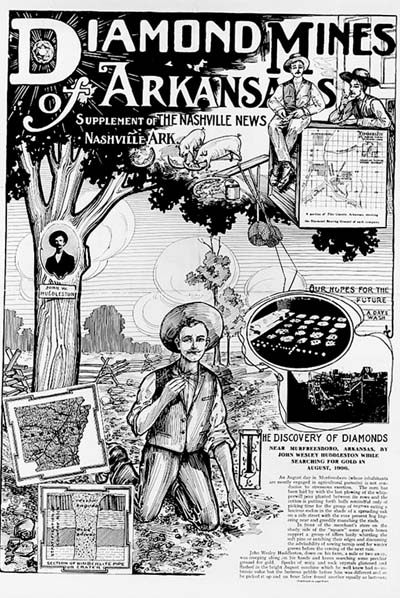Diamonds are this Park’s Best Friend

Mine shaft at Craters of Diamond State Park. (Photo: Doug Wertman/flickr)
There is “no such thing” as a “typical day” for Waymon Cox, who works in a state park in Murfeesboro, Arkansas. But the events that upset his routine are not quite the same ones most state park employees grapple with.
“Diamonds will come in and we’ll register them, and sometimes we’ll have a large diamond found and we’ll have to register it and spend time writing a news release and photographing the diamond,” says Cox. “And things like that.”
So it goes at Crater of Diamonds State Park, the only keep-what-you-find diamond site in the world (that they know of).
Crater of Diamonds got its start about three billion years ago, when intense pressure and heat caused carbon to crystallize into diamonds about 60 to 100 miles beneath the earth’s surface. Around 100 million years ago, a massive explosion pushed the diamonds from their subterranean home, so that they lay nestled in the soil. After this dramatic introduction to the surface, they lay undisturbed until the early 20th century when a farmer named John Wesley Huddleston (aka the “Diamond King” of Arkansas) uncovered a few diamonds on his property.

Diamonds in the rough. (Photo: ZhaoScorpio/flickr)
Huddleston sold his land to a commercial mining company, and thus began a diamond rush.
Would-be miners flocked to the area, and a tent city sprang up. Commercial mining efforts never took off, and the property changed hands a few times. There were unsuccessful attempts to mine diamonds underground, and eventually it was run as a tourist attraction. In 1972 the state of Arkansas handed over $750,000 in exchange for the property. Today, visitors willing to fork over $8 can spend all day digging for diamonds on a 37.5 acre field.
Cox is a park interpreter: “We interpret the resources of our respective parks, whether it be a lake or a mountain or a diamond mine.”
Cox spends his days educating visitors about the park, answering their questions and, of course, teaching them how to search for diamonds. The park recommends three methods. You can just walk around the field and look for them. (That works best after rainfall.) You can dig through the dirt and sift it through a screen. (That’s the most popular one.) Or you can go the labor intensive route, digging deep holes, sifting the soil more than once, and hand sorting the rocks and gravel. (The favorite method of serious hunters.) For the unprepared, tools such as shovels, screens, knee pads and buckets can be rented from the park.

The big question. (Photo: ZhaoScorpio/flickr)
The park may have never taken off as a commercial enterprise (although Bill Clinton re-explored this option—to some controversy—when he was the governor of Arkansas) but this isn’t because there aren’t diamonds to be found. It is the only diamond-producing site in North America, and it has offered up some truly remarkable gems, such as the 40-carat Uncle Sam, discovered in 1924. (For context, two carats is about the size of a pea.)
Thousands of visitors trek to the park annually—guests from every state and six continents have stopped by. The park keeps track of the diamonds found and some years the total exceeds 1,000. This year has produced 583 diamonds so far, including the 8.52-carat “Esperanza” diamond. (The park doesn’t provide estimates of the value of diamonds.) The diamond’s finder gets to name their rock; last names are popular, but sometimes people get whimsical.
For locals like Cox, who was born in Little Rock and raised in Murfeesboro, diamond hunting trips were de rigueur during childhood—a blingier version of a trip to the zoo. He has worked at the park since 2004.
Cox has found three diamonds. The average park visitor is rarely so lucky. When a possible diamond is found, they are brought to a park employee for inspection. (There are other minerals in the dirt that some mistake for diamonds, such as quartz or jasper.) After imposters are ruled out, the diamond is passed to one of four park workers qualified to certify a diamond, of which Cox is one. This process can be a bit like a science experiment. If the diamond can’t be visually confirmed, Cox may employ one of several methods. These include scratching the rock with silicon carbide (a compound that will scratch everything but a diamond), a “gravity test” where the rock is immersed in chemicals to see if it sinks, or (if it’s a large stone) a “thermo conductivity test” where a special probe is touched to the suspected diamond.
Once confirmed, the finder will be issued a certificate with the weight, color, and date the diamond was found. Any diamond over two carats gets a press release.

A supplement to the Nashville News newspaper promoting diamond mining. (Photo: Wikimedia Commons)
A 3.85 carat diamond found in 2013 called the God’s Jewel was sold to a collector for $20,000. The Esperanza Diamond will be auctioned off in December. Some reap rewards that can’t be predicted: After a man named his diamond “Sweet Caroline” for both his wife and the song, the couple was flown out to Los Angeles to appear on a talk show and attend a —what else— Neil Diamond concert.
“If you’ve got a large enough diamond,” says Cox, “People will find you.”
A big find typically causes a surge of visits to the park—everyone wants to find their Esperanza. But regulars know that it’s highly unusual to unearth such a gem on their first try.These experienced rock hounds—some that visit almost every day— have reported that it takes around a hundred buckets of dirt to find a diamond. Cox says he doesn’t know anyone who has made their living exclusively off diamonds from the park but some have come close. One particularly well-known repeat visitor made almost daily visits to the park for 30 years, and after retirement he became a fixture. Some estimates place his haul at thousands of diamonds.
“People say he put his kids through college with the diamonds he found here,” says Cox. “He bought a truck with the diamonds he found here.”









Follow us on Twitter to get the latest on the world's hidden wonders.
Like us on Facebook to get the latest on the world's hidden wonders.
Follow us on Twitter Like us on Facebook